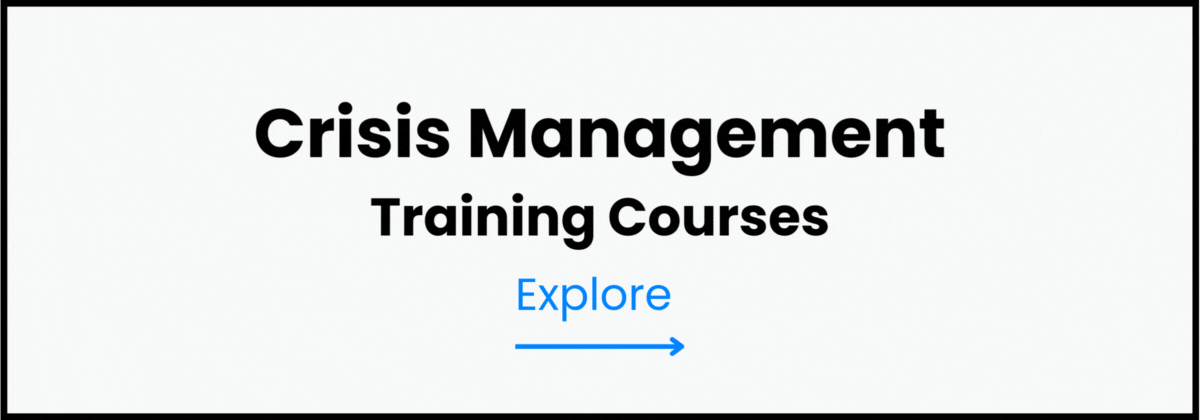What is Crisis Management? Frameworks, and Stages
Introduction To Crisis Management
In today’s uncertain business landscape, understanding what is crisis management has become essential for organizations of all sizes. At its core, crisis management is the process of preparing for, responding to, and recovering from unexpected events that have the potential to disrupt operations, damage reputation, or endanger people. These events can range from natural disasters and cyberattacks to product recalls, financial instability, or workplace accidents.
A clear crisis management definition highlights it as a structured approach that enables organizations to anticipate risks, establish response protocols, and ensure continuity when faced with disruptions. It is not only about reacting to emergencies but also about building systems and strategies that minimize impact and support rapid recovery.
The true crisis management meaning lies in its ability to safeguard organizational resilience, protect stakeholders, and preserve long-term trust. Companies that invest in crisis management practices are better equipped to reduce operational downtime, comply with regulatory expectations, and maintain a strong reputation even in challenging times. In short, effective crisis management transforms uncertainty into an opportunity for preparedness and adaptability. Explore Our: Crisis Management Training Courses

Importance of Crisis Management in Organizations
The importance of crisis management extends far beyond emergency response. It provides organizations with a proactive framework to safeguard people, assets, and operations when faced with sudden disruptions. By embedding crisis management strategies into their culture, companies strengthen resilience and maintain stability even under pressure.
The key benefits of crisis management include:
- Protecting employees, assets, and stakeholders – ensuring safety measures and response plans minimize harm during emergencies.
- Reducing reputational and financial damage – mitigating risks that could otherwise lead to costly downtime, legal liabilities, or brand loss.
- Ensuring compliance with laws and safety standards – meeting regulatory obligations and avoiding penalties through structured preparedness.
- Building trust and confidence with customers and partners – demonstrating reliability and accountability during challenging circumstances.
When crisis management is taken seriously, organizations are not only able to respond effectively to unexpected events but also build a culture of trust and preparedness. This strategic approach supports long-term sustainability, enabling companies to turn potential threats into opportunities for growth and resilience. Explore Our: Emergency Response Management Training Courses
Crisis Management Plan
A crisis management plan is a documented framework that guides organizations in preparing for, responding to, and recovering from disruptive events. It ensures that when a crisis occurs, the organization is not caught off guard but instead has a clear roadmap for action. Unlike ad-hoc reactions, a well-structured crisis response plan provides clarity, reduces panic, and helps maintain continuity.
Key components of an effective crisis management plan include:
- Risk assessment and scenario planning – identifying potential threats such as cyberattacks, natural disasters, supply chain disruptions, or reputational risks, and evaluating their possible impact.
- Emergency communication strategies – outlining how to deliver timely, accurate, and transparent information to employees, stakeholders, customers, and the media.
- Response protocols and responsibilities – assigning clear roles and decision-making authority to ensure accountability and coordinated action during emergencies.
- Recovery and business continuity measures – detailing steps to restore operations, protect critical functions, and implement long-term improvements after the crisis.
Every organization, regardless of size or industry, needs a written plan. A documented crisis response plan not only ensures compliance with safety and regulatory standards but also strengthens stakeholder confidence. By having predefined strategies in place, companies can act decisively, minimize damage, and recover faster—turning crisis preparedness into a competitive advantage.
Check Course: Creative Leadership in Crisis Course
Crisis Management Team
A well-prepared crisis management team (CMT) is essential for guiding organizations through disruptive events. This dedicated group ensures that crises are managed with speed, clarity, and precision, reducing confusion and helping the organization recover effectively.
Team Composition
The composition of a crisis management team typically includes leaders from critical functions who bring diverse expertise to the table:
- Executives – provide authority for decision-making and allocate resources.
- Operations managers – oversee continuity of business functions and logistical response.
- Communications specialists – manage internal and external messaging to employees, media, and stakeholders.
- HR representatives – address employee welfare, safety, and workforce management.
- Legal advisors – ensure compliance with regulations and reduce liability risks.
Responsibilities of a Crisis Management Team
Key roles in crisis management carried out by the CMT include:
- Making high-level decisions under pressure.
- Coordinating cross-departmental efforts to ensure a unified response.
- Communicating accurate information to stakeholders in real time.
- Monitoring developments and adapting strategies as the crisis evolves.
Importance of Training and Simulations
Even the best-structured crisis management team requires ongoing preparation. Regular training sessions and simulation exercises build confidence, sharpen decision-making, and test the effectiveness of crisis response protocols. This proactive approach ensures that when a real crisis occurs, the team can respond decisively and minimize disruption.
Check Course: Disaster Recovery Training Course
Crisis Management Framework
A crisis management framework provides organizations with a structured approach to prepare for, respond to, and recover from disruptive events. Instead of reacting on instinct, these models ensure decisions are consistent, resources are allocated effectively, and responsibilities are clearly defined. By using established models of crisis management, companies strengthen resilience and improve their ability to safeguard people, assets, and reputation.
Example Frameworks in Crisis Management
- 4Rs Model: Reduction, Readiness, Response, Recovery
- Reduction: Identifying risks and implementing preventive measures to minimize potential impact.
- Readiness: Building crisis plans, training staff, and conducting simulations to enhance preparedness.
- Response: Taking decisive action during a crisis to protect people, maintain operations, and reduce losses.
- Recovery: Restoring normal operations and learning lessons to strengthen future resilience.
- MIT Crisis Management Framework
This model emphasizes proactive planning, real-time decision-making, and continuous improvement. It integrates strategy, communication, and operations to create a holistic response system. By focusing on adaptability and speed, it enables organizations to respond effectively to rapidly evolving crises.
Why Frameworks Matter
The use of a structured crisis management framework guides leadership in making informed decisions and ensures resources are directed to the areas of greatest need. Frameworks also provide consistency, enabling teams to work together under pressure with clarity and purpose. Ultimately, they transform crisis management from a reactive process into a proactive, strategic discipline.
Check Course: Emotional Intelligence During Times of Crisis Course
Stages of Crisis Management
The stages of crisis management outline a clear roadmap for how organizations can anticipate, address, and learn from disruptive events. This structured approach transforms crisis response from a reactive scramble into a strategic process that safeguards people, assets, and reputation. Understanding each stage of the crisis management process helps organizations remain resilient and better prepared for future challenges.
The Five Stages of Crisis Management
- Stage 1: Mitigation & Prevention
Identifying potential risks and vulnerabilities before they escalate. This includes risk assessments, scenario planning, and implementing safeguards such as safety systems, cybersecurity controls, and compliance measures. - Stage 2: Preparedness
Building comprehensive crisis plans, training staff, and ensuring resources are in place. Preparedness also involves simulations and drills to test response capabilities. - Stage 3: Response
Taking immediate action during a crisis to protect employees, stabilize operations, and communicate effectively with stakeholders. The goal is to minimize damage and restore control quickly. - Stage 4: Recovery
Restoring normal operations, addressing reputational impact, and ensuring business continuity. Recovery also includes providing support to employees and rebuilding stakeholder trust. - Stage 5: Learning
Reviewing the crisis event, identifying lessons learned, and updating strategies to strengthen future readiness. This continuous improvement stage ensures the organization evolves with each experience.
By following these stages, businesses can navigate the crisis management process systematically—ensuring not just survival, but long-term resilience and growth.
Explore Courses From Our Top Categories:
➡️Business Training Courses – ➡️ Data Training Courses – ➡️ Technical Training Courses – ➡️ HSSE Training Courses
Real-World Examples of Crisis Management
Looking at crisis management examples helps illustrate how organizations can either protect or damage their reputation depending on how well they respond. Effective crisis handling not only minimizes immediate disruption but also reinforces trust with employees, customers, and stakeholders.
Airline Responding to a Safety Incident
When an airline faces a safety-related emergency, rapid response is critical. Effective crisis handling involves prioritizing passenger safety, coordinating with emergency services, and communicating transparently with the public. Airlines that act swiftly—grounding aircraft, offering support to affected passengers, and explaining corrective measures—often restore confidence quickly. Conversely, delays in communication or lack of empathy can severely damage trust and brand reputation.
Company Handling a Data Breach
Data breaches are becoming one of the most common corporate crises. A strong response includes notifying affected customers promptly, offering credit monitoring services, and publicly explaining what steps are being taken to strengthen cybersecurity. Transparency and accountability in these crisis management examples often make the difference between retaining customer trust and facing long-term reputational harm.
Lessons Learned
- Organizations that act quickly, communicate clearly, and show empathy demonstrate effective crisis management.
- Poorly handled crises—where companies deny, delay, or deflect responsibility—often lead to greater financial losses, regulatory penalties, and long-term damage to reputation.
By studying both positive and negative crisis handling cases, businesses can refine their own plans and ensure they are better prepared to face unexpected challenges. View ISO IEC 22301 Course
FAQs on Crisis Management
To provide further clarity, here are some of the most common crisis management FAQs that organizations and professionals often ask:
-
What is the main purpose of crisis management?
The main purpose of crisis management is to protect people, assets, and reputation during unexpected events. By following a structured crisis management framework, organizations can minimize disruption, ensure safety, and recover more effectively.
-
What are the key stages of crisis management?
The key stages of crisis management include mitigation and prevention, preparedness, response, recovery, and learning. Together, these stages form a systematic process that strengthens organizational resilience.
-
Who should be on a crisis management team?
A dedicated crisis management team typically includes executives, operations leaders, communications specialists, HR representatives, and legal advisors. This diverse group ensures that the crisis management plan is executed effectively across all areas of the organization.
-
How often should a crisis management plan be updated?
A crisis management plan should be reviewed and updated regularly—at least annually, or after any major incident. Frequent updates ensure that risk assessments, response protocols, and communication strategies remain relevant and effective in an evolving environment. Check: Crisis Management in Emergency Situations Course
Conclusion
Effective crisis management is no longer optional—it is a necessity for ensuring resilience and business continuity in today’s unpredictable environment. By investing in a structured crisis management plan, organizations equip themselves with the strategies, resources, and confidence needed to respond to disruptions quickly and effectively.
The structured stages of crisis management—from prevention and preparedness to response, recovery, and learning—provide a clear roadmap for navigating uncertainty. Organizations that follow these stages are better positioned to protect employees, safeguard assets, and maintain stakeholder trust, even in the most challenging circumstances.
To thrive in an era of constant change, companies must build strong crisis management frameworks, empower dedicated teams, and commit to continuous improvement. With the right planning and execution, crises can be transformed into opportunities to demonstrate resilience, responsibility, and long-term strength.
Also View Our
Training Courses in Dubai – Management and Leadership Training Courses – Strategic Management Courses





